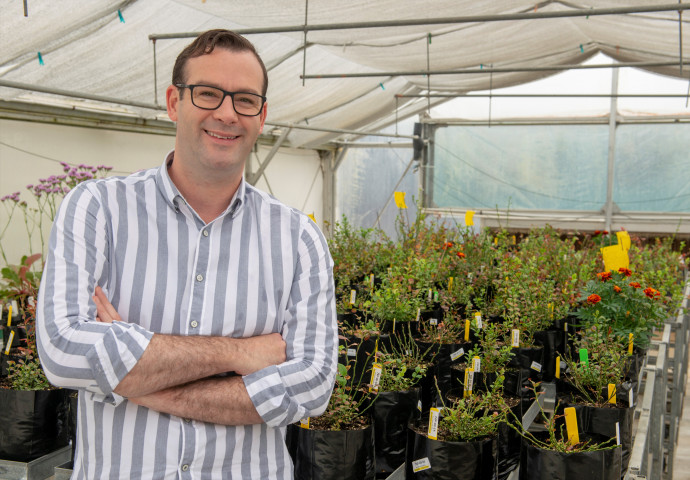2020 Hamilton Award: Understanding novel colours, enhanced nutrition and ‘sunscreen’ in plants

Dr Nick Albert has been awarded the Hamilton Award, the Royal Society Te Apārangi Early Career Research Excellence Award for Science, for his research into plant pigments as a plant geneticist.
The award is presented for his major contribution to understanding the compounds responsible for making different colours in plants, their origins and how they are controlled. This knowledge is aiding the development of fruits with novel colours and enhanced health-promoting compounds. He has also made discoveries in when and how the earliest land plants acquired their “sunscreen” properties to cope with environmental stress factors such as UV-B during evolution.
Nick primarily studies how plants control the production of flavonoids and anthocyanin pigments, which provide colour and health-promoting properties to fruit and vegetables. He focuses on identifying the genes responsible for regulating where, when and the amount of phytochemicals plants produce. He has demonstrated that a class of gene acts to inhibit the production of anthocyanin pigments, and suggested that these genes are important targets for marker development in breeding programmes.
Nick currently leads research investigating why anthocyanins are usually limited to fruit skin, within a research programme that aims at developing novel berryfruit with enhanced anthocyanin content.
In 2014, he published a highly impactful paper that described the mechanism of genes in petunia that inhibit the production of anthocyanin, pigments associated with antioxidant effects, and how they interact with all the other colour genes. This discovery was significant not only to growers of the ornamental plant but also to horticulturalists and agriculturalists because the models have since been confirmed in multiple species and crops grown for human and animal consumption.
In 2016, Nick was awarded a Marsden Fast-Start grant investigating how “bulls-eye” anthocyanin patterning is controlled in snapdragon flowers. These patterns are recognised by insect pollinators and their preferences for particular colour patterning has directed species development within the snapdragon genus.
He has recently completed a Marsden-funded research project that has shown that flavonoid biosynthesis for UV-B protection is an ancient trait that evolved early during the evolution of plants from aquatic environment to land. It was previously believed that the red pigments in liverworts, one of the closest living relative to the first land plant, came from anthocyanin. Dr Albert has identified a new flavonoid called auronidins that is actually responsible for the pigments and the genes that regulate the flavonoid.
On receiving the award, Nick said:
"This award is a great honour, recognising years of research into a subject that I’m passionate about. I thank my amazing team members for their support and for making each day at work fun. I also thank my mentors and supervisors, in New Zealand and abroad, for their encouragement throughout my career."
Nick is a scientist in the New Cultivar Innovation team at Plant & Food Research in Palmerston North. His contributions to plant genetics have earned him the Roger Slack Award in Plant Biology 2014 by the New Zealand Society of Plant Biologists and the Science New Zealand Plant & Food Research Early Career Researcher Award in 2019.
Hamilton Award:
For encouraging scientific research in New Zealand by early career researchers.
Citation:
To Nick W. Albert for his contributions to understanding the compounds responsible for making different colours in plants, their origins and how they are controlled.
